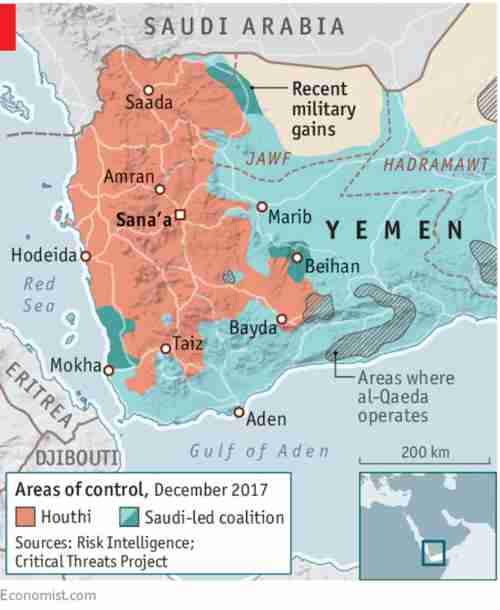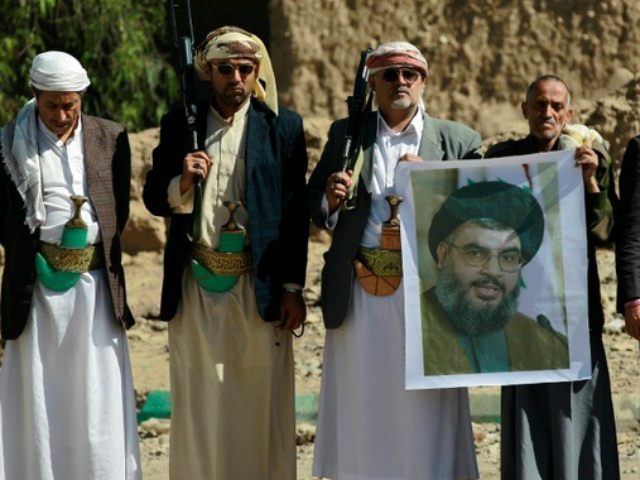This morning’s key headlines from GenerationalDynamics.com
- Iranian advisors are ‘on the ground’ with Houthis in Yemen, supplying weapons and intelligence
- Forces realign in the Yemen war following the death of Ali Abdullah Saleh
Iranian advisors are ‘on the ground’ with Houthis in Yemen, supplying weapons and intelligence

Map of Yemen showing areas controlled by Houthis, Saudi-led coalition, and al-Qaeda (Economist)
On Friday, Iran-backed Shia Houthis launched a ballistic missile from Yemen into Saudi Arabia’s southwestern province of Najran. The Saudi military confirmed the launch, but said that it did no damage, as it was intercepted by Saudi air defenses of Najran.
The Houthis have launched several missile attacks on Saudi Arabia recently, and the Iranians have been accused of supplying the Houthis with these missiles and other weapons.
However, the death of Ali Abdullah Saleh last month provides unique evidence that not only is Iran supplying weapons to the Houthis, it is also providing intelligence and possibly directing all the actions of the entire Houthi force.
Saleh’s Sunni forces had been working side-by-side for years with the Houthis in opposition to the Saudi-led coalition. This alliance was always a marriage of convenience of two groups that disliked each other, and it was not surprising when the alliance finally fell apart on December 4 of last year. Two days later, the Houthis ambushed Saleh and killed him and his entire family.
The Houthis gained a huge cache of weapons and they killed many of Saleh’s former aides and fighters, but not all of them, and some of them fled to Aden.
BBC reporter Nawal Al-Maghafi, speaking on the BBC World Service on Friday, said she had tracked down Saleh’s closest aide, now in Aden. The aide said:
I was with him, and he was defending his home, with his aides and nephews by his side. Three or four tanks surrounded his house. They began firing.
Al-Maghafi asked the aide about the presence of Iranians, and he said:
There are Iranians by their side, and they tell them exactly what to do. I saw them with my own eyes. They give them weapons, but it’s the information they give that is most important. I met the Iranian advisers when I was with Saleh. They were always beside the Houthi leaders.
Al-Maghafi said that while she was in Sanaa, she was able to speak with “other well-placed sources [who] all confirmed the existence of the Iranian advisers.”
Iran’s substantial support for the Houthis has been long suspected but, of course, always denied by the Iranians. Al-Maghafi’s reporting provides the first on-the-ground proof of the Iranian support. AFP and Al Jazeera and Sky News
Forces realign in the Yemen war following the death of Ali Abdullah Saleh
The Yemen war began for real in March 2015, when the Iran-backed Houthis took control of the capital city Sanaa, forcing the Sunni government to flee to the port of Aden in the south. Since then, at least 10,000 civilians have been killed, mostly in airstrikes in the Saudi-led coalition against the Houthis. There have been 40,000 injuries.
According to UN humanitarian official Mark Lowcock:
The situation in Yemen – today, right now, to the population of the country – looks like the apocalypse.
The cholera outbreak is probably the worst the world has ever seen with a million suspected cases up to the end of 2017.
[A] terrible new epidemic of diphtheria (a bacterial disease which should be completely preventable by immunization) has already affected up to 500 people with dozens and dozens of deaths in the past few weeks. That is going to spread like wildfire.
Unless the situation changes, we’re going to have the world’s worst humanitarian disaster for 50 years.
The war worsened substantially when the Houthis launched another ballistic missile on November 4. It reached the King Khalid International Airport near Riyadh, about 800 km from the Yemen border, the farthest any Houthi missile had traveled.
In retaliation, Saudi Arabia broadened a land, air, and sea blockade, preventing even food and medicines from entering Yemen. This was threatening massive starvation and causing a deepening and increasing humanitarian disaster that was too much for Ali Abdullah Saleh, who at that time was still in his marriage of convenience with the Houthis. Saleh split with the Houthis and offered to mediate between the Houthis and the Saudis.
On December 4, the Houthis ambushed Saleh and his family, killing them all.
Since that time, there has been a realignment of forces. Some of Saleh’s fighters have stayed with the Houthis, but most of them have headed south to Yemen, joining the official Yemen army still led by former president Abdrabbuh Mansur Hadi.
According to some reports, the Houthis have been losing ground to Yemen army, backed by Saudi coalition airstrikes, but things are extremely fluid.
We can now be certain that the Yemen war is a full-fledged proxy war between Saudi Arabia, which is providing airstrikes and weapons to Yemen’s army, versus Iran, which is providing weapons, intelligence, and direction to the Houthis. It seems certain that the Yemen war is not nearly over. Al-Ahram (Cairo) and Al-Jazeera and Arab News and The National (UAE)
Related Articles
- Three crises accelerate: Yemen’s Saleh killed, Brexit collapses and North Korea war looms (05-Dec-2017)
- Yemen war changes direction with collapse of Iran-backed Houthi coalition (03-Dec-2017)
- Saudi Arabia blockades Yemen, threatening millions to die in famine (10-Nov-2017)
- Yemen’s Houthi missile attack on Riyadh called a ‘dangerous escalation’ (06-Nov-2017)
KEYS: Generational Dynamics, Yemen, Saudi Arabia, Najran, Iran, Houthis, Ali Abdullah Saleh, Sanaa, Aden, Nawal Al-Maghafi, Mark Lowcock, Abdrabbuh Mansur Hadi
Permanent web link to this article
Receive daily World View columns by e-mail

COMMENTS
Please let us know if you're having issues with commenting.